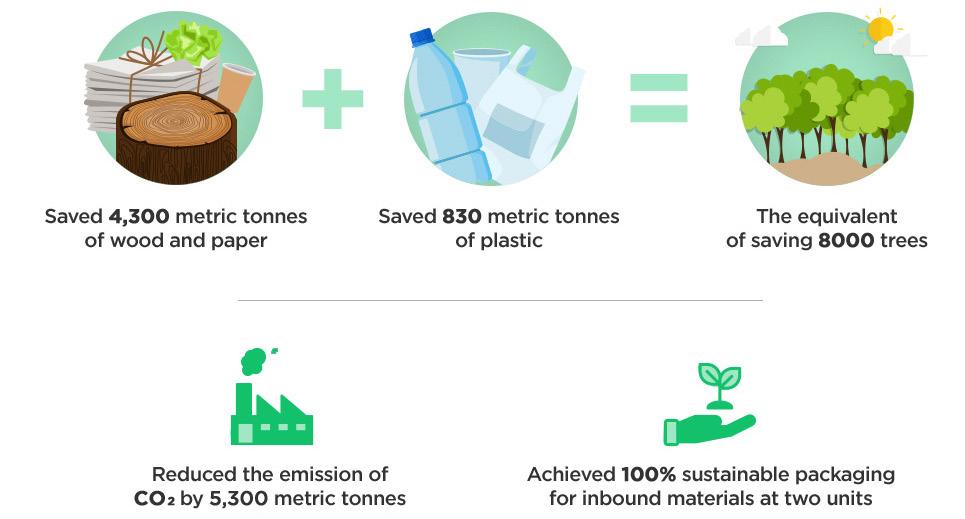UNDER-40 SUPER ACHIEVERS
Augmenting Infrastructure Facilities to Boost Export Dr Abhijit Singh, Executive Director, Indian Ports Association, writes about the initiatives undertaken at Major Ports to transform them into world class facilities and to boost exports.
A
S part of Maritime India Vision (MIV) 2030, recently published by Ministry of Ports, Shipping and Waterways, globally benchmarked targets have been defined to help India develop best-in-class port infrastructure. The development of Indian Ports is estimated to drive cost savings to the tune of Rs6,000-7,000 crore per annum for EXIM clients and help unlock Rs70,000 75,000 crore worth of potential revenue. MIV 2030 targets 423 MTPA of capacity addition at Major Ports for the next 10 years. A total investment cost of over Rs33,400 crore has been envisaged for this capacity expansion. Out of this, approximately 95% capacity expansion is likely to be planned under Public Private Partnership (PPP)/ Captive mode by Major Ports. Currently, India has 5 Major Ports and 2 Non-Major Ports with greater than 100 MTPA capacity. There is a significant opportunity for India to setup Mega Ports and compete with global ports. In MIV 2030, based on detailed evaluation across key criteria for Mega Ports and emerging growth potential of clusters, 3 Mega Ports - Vadhavan-JNPT Cluster, Paradip Port, and Deendayal Port have been identified to be developed into Mega Ports with >300 MTPA capacity and Kamarajar is to be further evaluated in next 1-2 years for additional Mega Port on the East Coast. These Mega Ports on both East and West Coasts will be able to cater to high traffic potential in the next decade and develop Indian Port’s strategic importance in the South Asian region. Further, in order to modernize the infrastructure at ports, landlord model adoption for berth operations is being
14 CELERITY May - June 2021
promoted at Major Ports. As part of the long-term strategic interventions, Major ports need to move to a landlord model and bring in more private sector participation to drive operational efficiency. Apart from physical infrastructure, there is a strong focus on strengthening the digital infrastructure of ports. Several initiatives have been undertaken in recent times to improve Ease of Doing Business in Indian Maritime sector. For instance, The Port Community System (PCS) 1X has been operationalized in 19 port communities across 27 stakeholder types, thus enabling vessel related message exchange between ports and customs. Enterprise Business System (EBS) is under implementation at 6 Major Ports (Mumbai, Chennai, Deendayal, Paradip, V.O. Chidambaranar, and SMP Kolkata) and will be extended to other ports in the future. Moreover, Indian ports have adopted some digital initiatives such as on-road examination of containers, automated gate processing enablement, online berthing systems, etc. Further, Ministry of Ports, Shipping and Waterways (MoPSW) is leading charge to create a unified logistics system – National Logistics Portal (NLP) – integrating all supply chain elements in India across various modes of transport like roads, railways, etc. As a part of the same, a National Logistics Portal (NLP) Marine has been envisaged to solve many current EXIM challenges. This step is aligned with the global trend of building end-to-end supply chain solutions in shipping. NLP Marine will be developed in conjunction with the existing PCS1x platform and will provide API integration facility with various Port Operating Systems, Terminal Operating Systems,
Dr Abhijit Singh is an accomplished maritime professional and passionate educationist with multifaceted work experience in shipping, on-shore and as well “at sea”. He attained the distinction of becoming the youngest senior officer, equivalent to Deputy Chairman of Major Port at the age of 34 years. In the past, he sailed onboard ship and worked onshore in senior capacity with UK based oil major shipping company. He is closely involved in the policy decision-making process to bring sectoral reforms by making ports as drivers of economic change, saving logistic cost & time, easing port congestion, enhancing employability, capacity building and digitalizing & modernizing of ports.
and other stakeholder(s) systems. This entire ecosystem will be built on open standards with plug-and-play capabilities to allow changes at sub-system levels without affecting other parts and enable a heterogeneous multi-stakeholder environment to collaborate seamlessly.
Ed’s Note: What started as an initiative in the year 2019 to honor excellence of the young under-40 talents in supply chain, has today become a movement. We are now providing them a voice by way of this newly launched Celerity Supply Chain Super Achievers’ column. These voices are truly making a difference in the way supply chains function today and we would like to get their insights. Dr Abhijit Singh is a Celerity Supply Chain Super Achiever 2020





